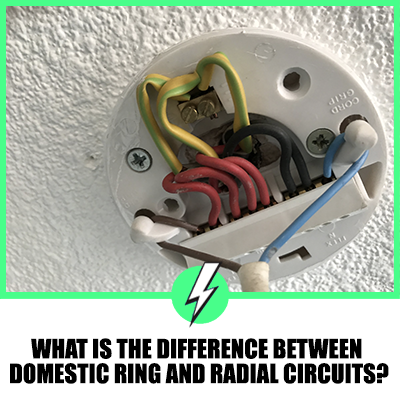What Is The Difference Between Domestic Ring And Radial Circuits?
Would it be simpler to have a ring main for all of your lighting circuits and a ring main to run your appliances?
Your lighting circuit will likely be a ring that comprises 3 wires coming from a breaker in the consumer unit because a load of a lighting circuit is relatively small compared to appliances to use a smaller cable. A radial circuit will supply the items that need more amps, such as an immersion heater, shower, and washing machine.

Contents
Why does the UK use ring mains?
As with most things in the UK, the origins of how we work often go back to the 2nd world war, such as the term EN that we frequently see but was the Emergency Number assigned to an item.
There was a copper shortage in history, so the ring main was devised to save on copper. The ring main circuit starts and ends at the consumer unit in a continuous loop, hence the name ring circuit.
The ring circuit was designed to allow two 3kW electric fires to be used on the circuit simultaneously.
The official name for the circuit is a ring final circuit.
How many sockets can you have on a ring final circuit?
There is no limit to how many sockets you can use, providing the MCB is of sufficient capacity.
Typically the MCB will be rated 30 or 32 amp fuse or MCB (Miniature circuit breaker). If the feed cable is 4mm, any future spurs can also be rated at 30 or 32 amps.
The IET wiring regulations (BS7671) permit an unlimited amount of 13A socket outlets to be installed on a final ring circuit with the proviso that the floor area is not greater than 100㎡.
Can I take a spur off a ring main?
Yes. However, there are some rules that you need to be aware of. You are allowed one unfused spur to a socket (single or double) or have one fused spur top as many sockets as you need.
What’s wrong with ring circuits?
Safety, final ring circuits are misused and abused by homeowners by adding gang extensions and placing loads on the circuit that it was never designed to take.
The domestic installer who installed the final ring circuit never gave a lot of thought to how the circuit could be used, and often the MCB is not sufficient for the circuit. Or conversely, the MCB is ok, but the cable used in the circuit is not sufficient to handle the current.
If the latter scenario is true, then the cable could become hot and even start to burn, which is a nightmare scenario to be faced with.
What are the main advantages of the ring main system over the radial system?
It is said that there are fewer power fluctuations at the consumer unit, which prevents the breakers from inadvertently tripping.
However, due to the safety risks of misused and abused final ring circuits, the move is to use only radial circuits in domestic properties.
Should you use ring or radial circuits in your home?
Ring mains are the way out in domestic settings, and with the implementation of AFFDs, there is no need for the final ring circuit.
Electricians today install 32A radial circuits using 4mm cable or 16/20A radials in 2.5 mm cable, sectioning the house into different zones. You can wire each room as an independent radial circuit if you wish.
There is no need for junction boxes, they are not required, which saves you money, and they should be avoided as much as possible as they are a weak link in the circuit.
When would you use a radial circuit?
The radial circuit is considered safer than the final ring circuit, which suggests it can be used in all applications and replace the final ring circuit in domestic settings.
Radial circuits have traditionally been used for kitchens, utility areas, bathrooms and immersion heaters.
The common thread that connects everything in these home areas is the amount of power required.
Appliances and heaters use more power than common living areas and bedrooms, so the radial circuit uses thicker cable and a substantial breaker of around 32 A to cover the extra load in these areas covered by part P of the building regulations.
What’s the advantage of using a radial circuit?
A radial circuit is linear; it does not return to the breaker as the final ring circuit does. This makes the radial preferential when it comes to faults, the response from the breaker is instant, and the faulty can be identified easily.
The circuit can supply high power areas of the home and be used for lighting and wall sockets.
What are the disadvantages of radial circuits?
They are more expensive for the customer because each circuit requires a cable to return to the consumer unit, adding additional breakers and cable.
If the electrician has been used to working on final ring mains, then they may find wiring a radial circuit a little more complicated than they are used to.
What are the maximum amps on a radial circuit?
Up to 32A depending on the size of the cable but for most homes, a 16A or 20A breaker is sufficient to give adequate circuit protection.
Should you choose a Final ring or radial for your home?
There does seem to be some controversy over which is better in the home, but in terms of making a choice, you may not get that privilege.
For home circuits, it seems as if the radial circuit is the way to go, and any fears of not being able to detect a fault such as sparks or arcs have been negated with the introduction of AFFDs into RCBOs.
The big brown book 18th Edition has not stipulated what should be used, but in time it will.





